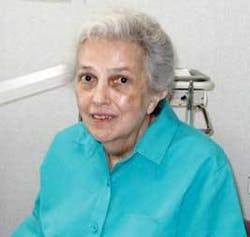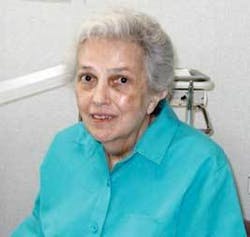Way back when
Two septuagenarians reflect back on the early days of their careers in dental hygiene.
More females than males now earn bachelor’s degrees, but it wasn’t so long ago that many girls couldn’t imagine schooling beyond high school. Those who did pursue more education generally chose teaching and nursing.
Who were the women who chose dental hygiene as a career 50-plus years ago? Joan Farist Penfield Begg and Alice Fallo Geosits are septuagenarian Connecticut women who live about 20 miles from each other. They have never met, and they came from different backgrounds. One practiced dental hygiene for only about two years; the other, though, is still practicing two days a week.
Dental hygiene was not Joan Begg’s first choice. In 1947 she enrolled at Endicott Junior College in Beverly, Mass. After receiving an associate’s degree in science, she decided to join the newly emerging occupational therapy field, which meant attending the Tufts University-affiliated Boston School of Occupational Therapy.
She said, “I love to work with my hands and I like science.”
But the program lasted five years. She had already attended Endicott for two years, and after the first year she realized she didn’t want to attend school for another three years. Her solution was to leave school and get a job working in a bank.
Begg’s father was an enlightened man for his time. Begg said, “My father said that nice young ladies had to be educated to have jobs to get by on. When I left Boston and worked at the bank, he didn’t think that was what I should do. So we talked and he called Dr. Strang.”
While Dr. Alfred Fones is considered the “father of dental hygiene,” Dr. Robert Strang, an orthodontist, was one of the visionaries behind the founding of the Fones School of Dental Hygiene at the University of Bridgeport in Connecticut. Begg’s father happened to know Strang, called him, and initiated Begg’s enrollment into the dental hygiene program.
Because of her previous education, she became the first person to receive a bachelor’s of science degree in dental hygiene education. Coincidentally, her aunt, Louise Sherman, had graduated in Fones’ second class around 1918, but her experience did not influence Begg’s decision.
Upon passing her board exams, she began working as a school hygienist. She remembers that children then had “lots of green stain.”
She said, “We used a pedal pump during the prophy and a spittoon that didn’t have water or antiseptic. The custodian put our chair in a box and we were ready to go from school to school.”
But Begg’s dental hygiene career was short-lived. She said, “I met my husband at the end of my first year practicing dental hygiene. We married six months later, and I got pregnant right away. In those days the belief was that ‘polite young ladies didn’t show,’ so after working as a hygienist for two years, my career ended.” Begg never returned to the dental hygiene field.
While working as a substitute teacher, she has spent, and continues to spend, most of her time as a community volunteer and active member of various organizations including the Daughters of the American Revolution.
She also does needlepoint, basket weaving, and rug hooking, demonstrating that she has not stopped enjoying working with her hands. In 1994 she and a friend wrote, published, and printed 500 copies of Pine Grove - A Walk Through the Past about a 95-acre Methodist campground founded by her grandfather and others in 1879, one of the first camps for summer retreats in the United States. Her great-great-grandfather served with the Union during the Civil War and she compiled 110 of his letters in a book for her family.
Although she never became that occupational therapist and practiced dental hygiene for two years, Begg said, “I used to think that my family wasted their money on my education, but I now realize they didn’t. College pays off for everyone because one learns to think.”
Mother's influence
Alice Fallo Geosits’ story offers a different perspective from Begg’s. Born in Norwalk, Connecticut, the aptitude test she took in high school indicated that she would do well as a floral designer, lab technician, or dental hygienist because she had a high level of manual dexterity. Soon she was an on-campus student at Temple University School of Dental Hygiene in Philadelphia enrolled in their two-year program.
Geosits’ mother was an advocate of education, and both of her parents believed in the importance of dental care - factors that influenced her decision to choose dental hygiene.
She said, “My mother was very intelligent; she graduated from high school, which was very unusual when she was young. She was determined that my brother and I would get good educations. She worked in a factory doing piece work and she didn’t want that life for us. She was also big on dental care. She came from Poland where she had lots of toothaches as a child. My father bartered work for dental treatment with a local dentist. The dentist did gold work and I still have some of the gold inlays he made for me. I also have all of my own teeth.”
She has been practicing dental hygiene for more than 50 years, and she said she has never regretted her career choice nor wished to be a dentist. She started out, like Begg, as a school hygienist, practicing in Norwalk from 1952-1959. She stayed home with her two children until they were teenagers and then she gradually reentered the field by working five hours on Saturdays.
Because she has practiced for so long, Geosits has seen many changes in how dental hygiene is practiced. She recalls that originally the sickle scaler was the only instrument available, so only supragingival calculus was removed. After Gracey curettes were developed, hygienists taught themselves how to use them. She says she still doesn’t scale deeply unless the dentist has administered Novocain, and then she does one quadrant at each appointment. She said, “I don’t like to hurt patients.” People who have taken a “ten-year break from having prophies” routinely get treated ultrasonically.
Thinking back to those long ago school children, she said, “It looked like a grenade had gone off in many of the seven and eight year olds’ mouths; the decay was so rampant. Some kids just had roots left.”
She remembers in the early years wearing a long white uniform with a lab coat over it. She had to wear the lab coat when she left the lab. One day she and a friend were walking down the street wearing their lab coats when a couple of eight year old girls spotted them. One girl asked if they were nurses.
Told they weren’t, the other girl said, “See, I told you they’re waitresses.”
Geosits has seen many changes in technology and antiseptic practices. When she began practicing, the short cone was used to take X-rays and staff were told it was fine to stand behind the unit; no lead aprons were used then.
Today she works two days a week, and since she lost her husband of 46 years recently, she said that continuing to work helps her to keep her sanity. She has seen the good and the ugly side of patient personalities, but no experience has discouraged her from continuing to practice. While she refers to herself as a “dental dinosaur,” Geosits is an inspiration to all hygienists who remain committed to their chosen professions.
Although Begg and Geosits’ lives took different routes after they got their dental hygiene educations, these women, and others like them, who pursued college educations when other women didn’t realize school was an option, should be engaged in conversation whenever they are met because they truly are inspirations to all aspiring young, and older people. Listen to their stories, and others like them, whenever they are willing to share them.

